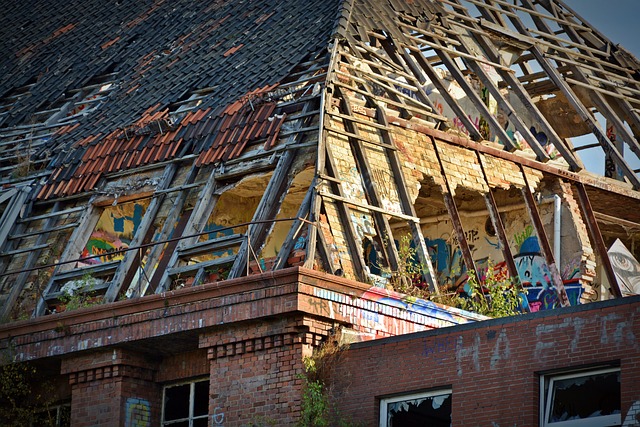Green roofs, or living roofs, are revolutionary sustainability solutions transforming urban spaces. These eco-friendly rooftop gardens offer natural insulation, heat absorption, improved air quality, and water retention, contributing to energy efficiency and stormwater management. With proper planning and maintenance, they foster biodiversity and create harmonious coexistence with nature. Green roofing technology is growing, simplifying installation, increasing plant diversity, and enhancing energy efficiency through innovative materials and smart technologies, making these sustainable roof systems increasingly accessible and appealing for urban environments.
Discover the transformative power of living roofs and their pivotal role in fostering eco-friendly homes. This article explores the multifaceted benefits of integrating green roof gardens into urban landscapes, serving as sustainable roofing solutions that reduce energy consumption and mitigate environmental impact. From understanding the core components of successful green roof systems to delving into cutting-edge installation methods and future trends, we uncover why these innovative designs are a game-changer for urban green roofs.
- Understanding Living Roofs and Their Benefits
- Components of a Successful Green Roof System
- The Impact on Urban Environments: Why Eco-Friendly Roofs Matter
- Installation, Maintenance, and Future Trends in Green Roofing Technology
Understanding Living Roofs and Their Benefits
Living roofs, also known as green roofs or rooftop gardens, are an innovative and eco-friendly approach to traditional roofing. This sustainable roof system involves planting a layer of vegetation on top of a building’s structure, offering numerous environmental benefits. By integrating nature into urban landscapes, living roofs transform ordinary rooftops into vibrant ecosystems that contribute to the overall health and aesthetics of a community.
The installation of green roofs provides an array of advantages. They act as natural insulators, reducing the need for heating and cooling systems, which leads to significant energy savings. These roof gardens also help mitigate urban heat islands by absorbing sunlight and releasing moisture, improving air quality. Moreover, living roofs provide habitats for local wildlife, support biodiversity, and enhance water retention, addressing issues like stormwater management. With their ability to create urban oases, reduce carbon footprints, and promote a harmonious connection between humans and nature, living roofs are gaining recognition as essential environmental roofing solutions in the pursuit of sustainable homes.
Components of a Successful Green Roof System
A successful green roof system is a harmonious blend of several components designed to mimic nature and enhance the environmental footprint of a building. The primary layers include a waterproof membrane, a drainage layer, a filter fabric, and growing medium – each playing a crucial role in supporting plant life while protecting the structure below from moisture intrusion. The choice of plants, whether native or adapted species, is key to creating an eco-friendly haven; they must be well-suited to withstand varying conditions and contribute to biodiversity.
Additionally, modern green roof technology often incorporates renewable energy elements like solar panels integrated into the design, enhancing energy efficiency. Access for maintenance and irrigation systems tailored to the specific needs of the plants further elevate the system’s sustainability. Urban green roofs, when implemented correctly, offer a myriad of benefits, from mitigating the urban heat island effect to providing insulation, thus contributing to more sustainable and aesthetically pleasing urban landscapes.
The Impact on Urban Environments: Why Eco-Friendly Roofs Matter
Living roofs, also known as green roofs or rooftop gardens, are transforming urban landscapes and offering a sustainable solution to some of the most pressing environmental challenges cities face. As urban areas continue to expand, the need for eco-friendly roofing solutions has become increasingly vital. Green roof installation involves integrating vegetation into a building’s structure, creating a vibrant ecosystem right in the heart of concrete jungles.
These innovative roofing systems provide numerous environmental benefits. They contribute to mitigating the urban heat island effect by offering natural insulation and absorbing excess heat, thereby reducing the need for energy-intensive cooling systems. Additionally, they help improve air quality by filtering pollutants and releasing oxygen, which is especially beneficial in densely populated areas. With their ability to capture and retain rainwater, living roofs also reduce stormwater runoff, easing pressure on sewage systems and promoting more sustainable water management practices.
Installation, Maintenance, and Future Trends in Green Roofing Technology
Green roofing technology has seen significant advancements in recent years, transforming rooftop spaces into vibrant ecosystems that promote sustainability and environmental consciousness. Installation of a living roof involves careful planning and execution, integrating various eco-friendly components such as soil, plants, and drainage systems onto a building’s structure. This process requires specialized knowledge and materials to ensure proper weight distribution, water management, and optimal growing conditions for the rooftop garden.
Regular maintenance is crucial for sustaining these sustainable roof systems. Regular weeding, irrigation, and fertilizing are essential tasks to keep the green roof thriving. As technology evolves, future trends in green roofing aim to streamline installation processes, enhance plant diversity, and improve energy-saving capabilities through innovative materials and designs. Environmental roofing solutions are increasingly integrating smart technologies for automated monitoring and control, making green roofs even more accessible and appealing for urban environments.
Living roofs, or green roofs, represent a powerful tool in creating sustainable and eco-friendly homes. By integrating vegetation into rooftop spaces, these innovative systems offer numerous benefits, including improved insulation, reduced urban heat islands, and enhanced water management. The components of a successful green roof, from drainage layers to plant selection, ensure its longevity and effectiveness. In urban environments, green roofs play a pivotal role in mitigating environmental impacts, providing habitats for local wildlife, and contributing to energy-saving solutions. As technology advances, the future of green roofing looks promising, with improved installation processes and maintenance requirements, making these sustainable roof gardens more accessible and appealing to homeowners and cities alike.
